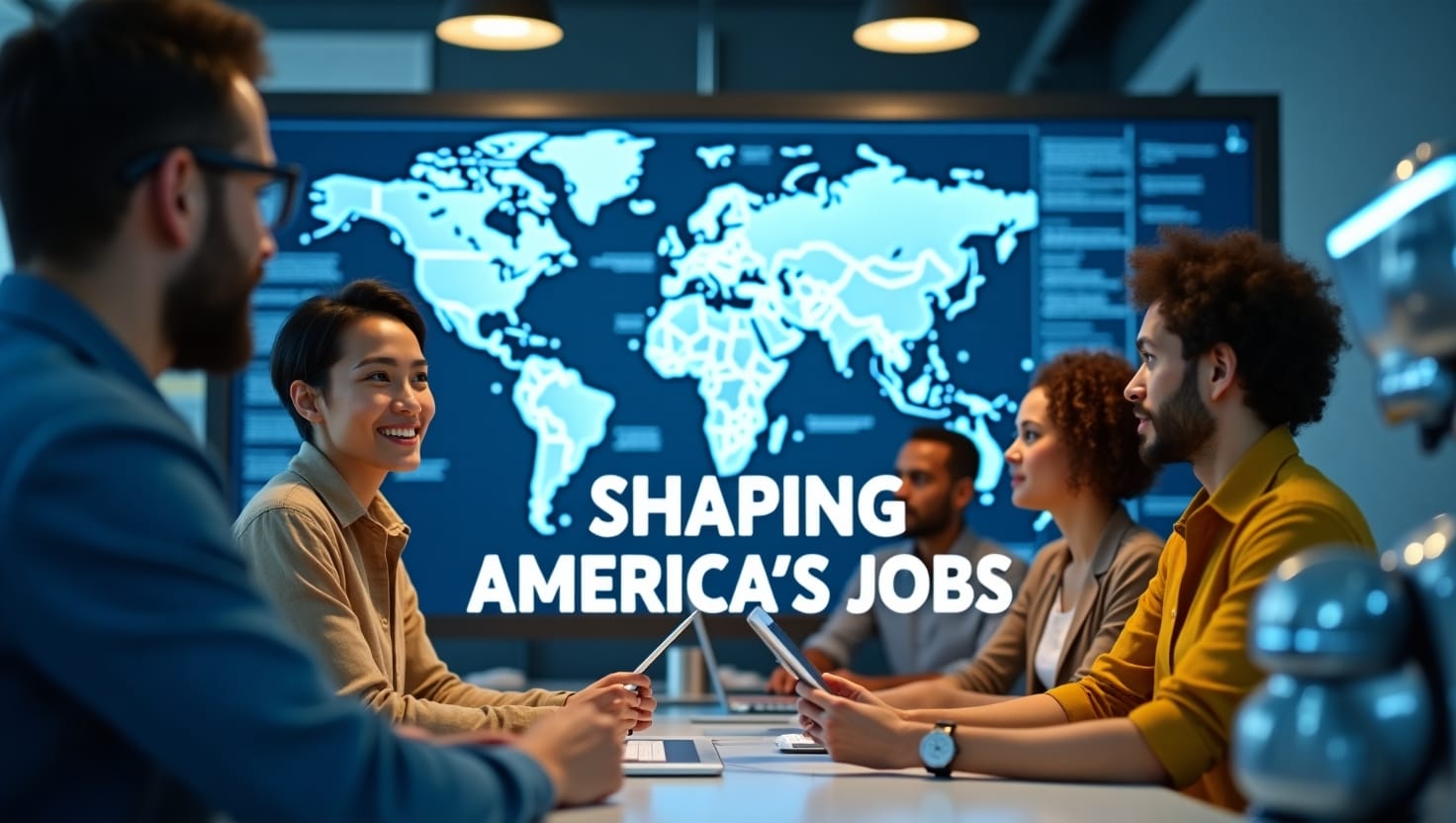
Artificial Intelligence is no longer a futuristic concept or experimental tool—it is now a defining pillar of the modern American workplace. According to a new report from Lightcast, a staggering 93% of U.S. companies plan to increase their investments in AI technologies. From automation to intelligent decision-making, AI is becoming integral to everyday business operations across industries.
But with this rapid transformation comes a complex duality: AI is simultaneously replacing and creating jobs, shifting skill demands and redefining what it means to be employable in the 21st century.
Artificial Intelligence is no longer a distant concept — it’s here, it’s growing fast, and it’s changing the way America works. From AI-powered employee training programs to automated workflows, the workplace of 2025 looks radically different from just a few years ago.
The integration of AI in both training and workplace operations offers enormous potential:
- Faster skill development.
- Smarter decision-making.
- Enhanced productivity.
But along with these opportunities come hidden risks — from job displacement to privacy concerns — that could reshape the future of employment in ways we’re only beginning to understand.
Let’s break down seven major opportunities and risks tied to AI training and its impact on the workplace.
1. Opportunity – Personalized AI Training at Scale
Traditional workplace training often follows a one-size-fits-all approach, which can waste time and fail to engage employees. AI changes this by creating personalized learning journeys:
- Platforms like LinkedIn Learning AI and Coursera AI Coach tailor lessons to each employee’s skills, goals, and learning style.
- Progress is tracked automatically, and AI adjusts content in real time to match the learner’s pace.
Example: A marketing associate might get AI-generated tutorials on advanced analytics, while a sales representative receives AI-driven roleplay scenarios to improve closing rates.
Hidden Risk: If training algorithms are built on biased data, they may unintentionally limit growth opportunities for certain employees or recommend only “safe” career paths.
2. Opportunity – Faster Onboarding for New Hires
AI-driven onboarding tools can shorten the time it takes for new hires to become productive:
- Automated introductions to company systems.
- AI chatbots answering policy questions 24/7.
- Simulated training environments that replicate real work situations.
Example: A new warehouse employee could be trained in equipment handling via AI-powered VR simulations before stepping on the floor.
Hidden Risk: Over-reliance on AI onboarding may reduce human mentorship, leaving new hires feeling isolated and disconnected from company culture.
3. Opportunity – Continuous Skills Upgrading
The modern workplace changes fast — skills can become outdated in less than two years. AI ensures employees are continuously trained:
- Real-time skills gap analysis.
- Microlearning modules that fit into daily workflows.
- AI-driven reminders and quizzes to reinforce knowledge.
Hidden Risk: Employees may feel pressured to constantly learn without adequate time or compensation, leading to training fatigue.
4. Opportunity – Enhanced Workplace Efficiency
AI doesn’t just train — it transforms work processes:
- Automating repetitive admin tasks.
- Analyzing large datasets for actionable insights.
- Scheduling meetings based on team availability and time zones.
Example: In HR, AI can screen thousands of resumes in minutes, allowing recruiters to focus on interviews and candidate engagement.
Hidden Risk: Automating too much can lead to over-dependence on AI, making companies vulnerable if systems fail.
5. Opportunity – Creating New AI-Centric Career Paths
With AI taking over routine work, new specialized roles are emerging:
- AI Ethics & Compliance Officer.
- AI Systems Trainer (teaching AI models with human feedback).
- Human-AI Collaboration Designer.
Hidden Risk: The demand for AI-centric roles could widen the skills gap between tech-savvy employees and those without access to advanced education or training.
6. Opportunity – Improved Decision-Making with AI Analytics
AI tools analyze employee performance, training progress, and workplace trends to guide managers in decision-making.
- AI identifies which employees are ready for promotion.
- Predicts which teams might struggle with deadlines.
Hidden Risk: Using AI analytics for performance evaluation could lead to over-surveillance and harm employee trust.
7. Opportunity – Safer and Smarter Work Environments
AI-powered workplace safety systems are already protecting employees:
- Sensors that detect hazardous conditions.
- AI monitoring fatigue levels in high-risk jobs.
Example: In manufacturing, AI can pause dangerous machinery the moment it detects abnormal activity patterns.
Hidden Risk: Workers may become complacent, assuming AI will always catch mistakes — which could be disastrous if systems fail.
AI Training in the Workplace – The U.S. Shift to Human-AI Synergy
AI is no longer just a “tech department” tool. It’s shaping every corner of the American workplace — from factory floors in Detroit to Silicon Valley’s startup hubs. What’s different in 2025 is the integration of AI into workforce training itself.
Instead of static training manuals, companies now offer dynamic AI learning ecosystems that update themselves as new technologies emerge. The pace is so rapid that skills learned today could be outdated in less than 18 months. This means workplace AI training has to be continuous, adaptive, and industry-specific.
AI Training Trends Across U.S. Industries
- Healthcare – Hospitals are using AI to train medical staff in diagnostics, robotic surgery assistance, and patient data analysis.
- Example: Mayo Clinic’s AI-based VR training simulates complex surgeries, letting new surgeons practice without risk to patients.
- Manufacturing – AI is training workers to operate autonomous machinery and predictive maintenance systems.
- Example: Ford’s AI-powered maintenance training reduced downtime in assembly lines by 23%.
- Finance – AI coaches train analysts to detect fraud patterns, assess risk, and automate compliance checks.
- Example: JPMorgan uses AI-based simulation training for regulatory updates, reducing manual errors by 40%.
- Retail & E-commerce – Staff are trained in AI-driven inventory forecasting, customer behavior prediction, and personalized marketing.
- Example: Walmart uses AI-based gamified training to help staff learn product stocking and AI-assisted customer service.
- Education – Teachers are being trained to use AI grading tools, personalized learning plans, and student performance predictors.
Hidden AI Training Risks Companies Overlook
While AI training is promising, many U.S. companies are blind to certain pitfalls:
- Skill Gap Acceleration: Workers without access to AI literacy programs risk falling behind, widening economic inequality.
- Algorithmic Bias in Training Content: If AI models generate biased learning material, employees may unknowingly adopt flawed methods.
- Data Privacy in Training Platforms: AI training tools collect employee performance data — if mishandled, it could breach worker privacy rights.
- Cultural Dilution: Over-reliance on AI-driven onboarding could weaken the company’s human-driven culture and mentorship bonds.
Case Study: AI Workplace Training at Boeing
Boeing launched an AI-powered virtual training environment for aircraft maintenance engineers.
- Impact: Reduced training time by 35% while increasing accuracy in mechanical diagnostics.
- Risk: Employees reported a drop in direct human mentorship, suggesting AI tools need to be paired with real-world peer learning.
How AI is Reshaping Workplace Learning Culture
Before AI:
- Yearly training workshops.
- One manual for everyone.
- Limited feedback loops.
With AI:
- Continuous microlearning.
- Adaptive training tailored to each employee’s pace.
- Real-time skill assessments with instant feedback.
Best Practices for AI-Driven Workplace Training
- Blend AI and Human Mentorship – AI can guide, but human context is irreplaceable.
- Update AI Models Regularly – Prevent outdated or biased learning material.
- Protect Worker Data – Use transparent privacy policies for AI tools.
- Gamify Learning – Make training engaging with AI-based interactive simulations.
- Measure ROI – Track training efficiency improvements in productivity and performance.
The U.S. Workforce in 2030 – A Prediction
By 2030, 85% of U.S. jobs will involve direct AI collaboration in some form — whether through decision-making assistants, predictive analytics, or automated systems. AI training will no longer be a “bonus skill” but a core job requirement.
Employers that act now to implement strong AI literacy programs will lead the market, while those that delay risk an unprepared workforce unable to compete in the AI-first economy.
Why AI Training is the Core of the AI Workplace Revolution
AI adoption will fail without proper employee training. If workers aren’t given the skills to collaborate with AI, productivity gains will stall and risks will rise.
- Businesses that invest in AI literacy for all employees will outperform competitors.
- AI training should include ethical guidelines and human oversight principles to prevent misuse.
The Road Ahead – Balancing Opportunity with Responsibility
The U.S. workplace is at a tipping point. AI training and automation offer unprecedented potential, but only if implemented with transparency, ethics, and inclusivity.
Key steps for employers:
- Build AI training into core company culture — not just as an optional benefit.
- Regularly update training programs to match evolving AI tools.
- Address the human element — mentorship, creativity, and empathy still matter in an AI-powered workplace.
tools to track keystrokes, screen activity, and productivity metrics — raising privacy concerns and impacting employee morale.
Layoffs in Tech, Gains in Non-Tech
One of the harshest realities of this AI wave is its impact on traditional tech roles. The Lightcast report reveals that up to 80,000 jobs have already been affected due to AI-driven automation, particularly in areas like:
- Data entry and software testing
- Routine programming tasks
- IT support and operations
These roles, often seen as the backbone of the tech sector, are now vulnerable to large language models, automation frameworks, and self-service AI tools that can execute repetitive tasks faster and more efficiently than humans.
But the story doesn’t end there.

AI Skills Are Powering Salary Boosts in Other Industries
While tech roles face disruption, non-tech sectors are experiencing a renaissance—at least for those who embrace AI fluency. Marketing, education, and human resources are leading the charge. Professionals in these industries who acquire and apply AI knowledge are seeing average salary increases of 28%, equating to an additional $18,000 per year.
Why the bump?
Because AI is now a critical tool in areas like:
- Marketing: Using AI for campaign automation, customer segmentation, sentiment analysis
- Education: Personalized learning, grading automation, virtual tutors
- HR: Resume screening, employee engagement insights, workforce planning
In short, AI doesn’t just enhance productivity—it enhances compensation.
The Rise of Hybrid Skillsets: Tech + Human
What employers want now isn’t just AI knowledge—they’re looking for hybrid professionals. The ideal candidate blends technical AI fluency with timeless human skills such as:
- Communication
- Emotional intelligence
- Creativity
- Critical thinking
This blend allows professionals to not only use AI tools, but also understand when and how to apply them ethically, strategically, and empathetically.
As a result, employability in the U.S. is being redefined. It’s no longer about degrees alone, but about adaptability and continuous learning.
Workplace Trends to Watch
Here are some trends that will likely shape the next phase of AI-driven employment in the U.S.:
🔹 AI Training is Becoming a Job Requirement: Companies are rolling out in-house AI upskilling programs, especially for mid-level managers.
🔹 Remote Roles Prefer AI-Ready Candidates: Job listings for remote work increasingly prioritize AI literacy.
🔹 AI Governance and Ethics Roles Are Emerging: With growing concern over bias and misuse, companies are hiring for AI ethics, auditing, and compliance roles.
🔹 “Prompt Engineering” is Becoming a Hot Skill: Mastering how to effectively communicate with AI (especially large language models) is turning into a competitive advantage.
Conclusion: AI is the New Normal—Adapt or Be Left Behind
The integration of AI in the workplace is not a temporary wave—it’s the new normal. It’s reshaping job descriptions, influencing pay scales, and requiring a new blend of skills.
For workers, this is a call to reskill and evolve. For companies, it’s a mandate to invest in their people as much as their technology. And for the economy at large, it’s the beginning of a redefined labor market where AI and human intelligence must work hand in hand.
📢 Stay ahead with more insights like this on USAtrends.tech – your daily dose of tech, innovation, and workforce trends shaping the future of America.





